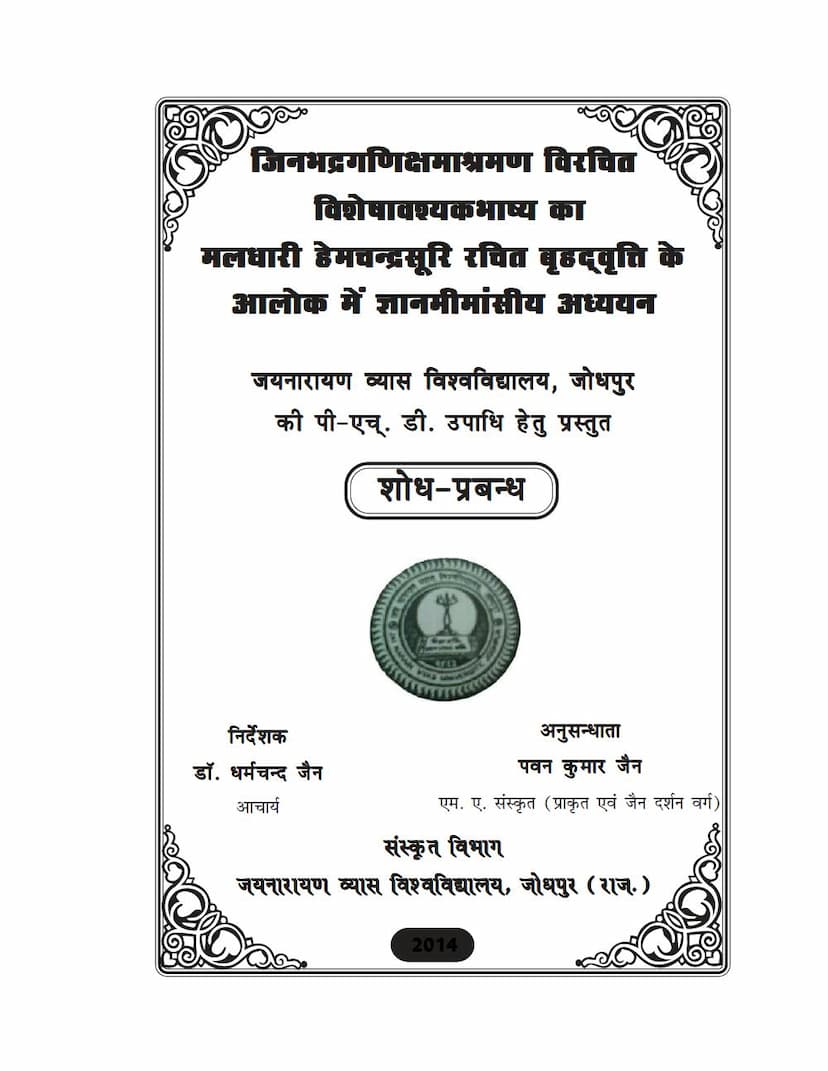Visheshavashyakbhashya Ka Maldhari Hemchandrasuri Rachit Bruhadvrutti Ke Aalok Me Gyanmimansiya Adhy
Added to library: September 2, 2025

Summary
This is a summary of the Ph.D. thesis titled "Visheshavashyakbhashya ka Maldhari Hemchandrasuri Rachit Bruhadvrutti ke Aalok me Gyanmimansiya Adhyayan" (A Epistemological Study of Jinbhadra Gani Kshamashraman's Visheshavashyakbhashya in light of Maldhari Hemachandra Suri's Bruhadvrutti) by Pavankumar Jain, published by Jaynarayan Vyas Vishwavidyalay, Jodhpur. The thesis was submitted for a Ph.D. in Sanskrit (Prakrit and Jain Philosophy) from the Department of Sanskrit, Jaynarayan Vyas University, Jodhpur, under the guidance of Prof. Dr. Dharmachand Jain Acharya.
The thesis is a comprehensive study of the concept of knowledge (Gyan) in Jainism, as presented in the Visheshavashyakbhashya, a commentary by Jinbhadra Gani Kshamashraman, and further elucidated by the Bruhadvrutti (a larger commentary) composed by Maldhari Hemachandra Suri. The research aims to delve into the epistemological aspects of Jain philosophy by analyzing these foundational Jain texts.
Here's a breakdown of the thesis's structure and content:
Introduction and Motivation: The author expresses a deep-rooted interest in Jain philosophy from childhood, which inspired them to pursue doctoral research in the field. Guided by their mentor, Dr. Dharmachand Jain, the author chose the topic, emphasizing its originality and the importance of knowledge in spiritual life, as highlighted by the Jain dictum "First knowledge, then compassion" (Padhamam nanam tao daya). The thesis aims to clarify the concept of knowledge in the Visheshavashyakbhashya and compare it with other Jain texts, also exploring the similarities and differences in the understanding of knowledge between the Shvetambara and Digambara traditions.
Structure of the Thesis: The thesis is divided into seven chapters, followed by a conclusion and bibliography.
-
Chapter 1: Visheshavashyakbhashya and Bruhadvrutti: An Introduction: This chapter introduces the Aavashyakasutra, its importance in Jain canon, and the various commentaries on it, including Niryukti, Bhashya, Churni, Vritti, and Tabba. It provides an overview of the Aavashyakasutra and its six essential practices (samayika, chaturvinshtistava, vandana, pratikramana, kayotsarga, pratyakhyana). It then introduces Jinbhadra Gani Kshamashraman, his life, times, and his seminal work, the Visheshavashyakbhashya. Finally, it discusses Maldhari Hemachandra Suri and his monumental commentary, the Bruhadvrutti (Shishyahrida), highlighting its unique features.
-
Chapter 2: Epistemology: A General Introduction: This chapter provides a general overview of epistemology in Jainism. It defines knowledge, its characteristics, and the relationship between knowledge and the soul (Atman). It discusses the various means of acquiring knowledge (indriya, man, atma) and the distinction between direct (pratyaksha) and indirect (paroksha) knowledge. It also touches upon the significance of knowledge in achieving liberation (moksha) and compares Jain epistemology with other Indian philosophical schools.
-
Chapter 3: Mati-jnana in Visheshavashyakbhashya: This chapter focuses on Mati-jnana (sensory and mental perception) as described in the Visheshavashyakbhashya. It elaborates on the differences between mati-jnana and shruta-jnana, the various classifications of mati-jnana (including shruta-nishrita and a-shruta-nishrita), and the specific stages of mati-jnana such as avagraha, iha, avaya, and dharana. It also discusses the different viewpoints on these concepts and their specific characteristics.
-
Chapter 4: Shruta-jnana in Visheshavashyakbhashya: This chapter deals with Shruta-jnana (scriptural knowledge) as analyzed in the Visheshavashyakbhashya. It explores the unique nature of shruta-jnana, its various classifications according to different sources like Anuyogadvartra, Aavashyak-Niryukti, and Shatkhandagama. It also examines the content of the twelve Angas and the concept of a-kshara shruta and akshara shruta.
-
Chapter 5: Avadhi-jnana in Visheshavashyakbhashya: This chapter provides a detailed exposition of Avadhi-jnana (clairvoyant knowledge) in the Visheshavashyakbhashya. It discusses its definition, the various bases for its classification, and the thirteen types of avadhi-jnana. The chapter also analyzes avadhi-jnana through fourteen nikshepas (categories of analysis) and discusses the concept of Riddhi (supernatural powers).
-
Chapter 6: Manah-paryav-jnana in Visheshavashyakbhashya: This chapter focuses on Manah-paryav-jnana (telepathic knowledge), explaining its meaning, terms, and how it differs from mati-jnana and avadhi-jnana. It describes the qualifications required to attain manah-paryav-jnana, its two main types (Rujumati and Vipulamati), and the controversies surrounding its scope.
-
Chapter 7: Kevala-jnana in Visheshavashyakbhashya: This chapter concludes the discussion on the five types of knowledge by analyzing Kevala-jnana (omniscience) as presented in the Visheshavashyakbhashya. It defines kevala-jnana, discusses the qualifiers used by past acharyas, and explores its subtypes based on the state of the possessor (bhavastha and siddha kevali). It also touches upon the role of shukla dhyana (pure contemplation) in attaining kevala-jnana and the differing views of Shvetambara and Digambara traditions on kevali samudghata (process of the omniscient) and the nature of kevali's knowledge.
Key Contributions and Findings: The thesis provides an in-depth analysis of the epistemological framework within Jainism, particularly through the lens of the Visheshavashyakbhashya and its commentary by Maldhari Hemachandra Suri. It highlights the detailed classification and explanation of the five types of knowledge (mati, shruta, avadhi, manah-paryav, kevala), the intricacies of sensory perception (indriyas), the role of the mind (manas), and the fundamental principles of Jain epistemology. The author attempts to showcase the sophisticated philosophical reasoning and analytical approach of Jinbhadra Gani and Maldhari Hemachandra Suri in understanding the nature and scope of knowledge.
Acknowledgements: The author expresses deep gratitude to their supervisor, Dr. Dharmachand Jain, for his invaluable guidance, and to other faculty members and scholars who supported the research. Special thanks are extended to Pujya Panditratna Shrutdhar Shri Prakashchandji M.S.A. for resolving complex scholarly issues and to Shri Laxmilalji Dak for inspiring the pursuit of Ph.D. The author also thanks various scholars and institutions for their contribution and support. The author particularly acknowledges the unwavering support of his wife, Ritu Jain, and his son, Kavya Kacholia.
Overall Significance: This thesis contributes significantly to the field of Jain studies by offering a detailed epistemological exploration of key Jain texts, thereby enriching the understanding of Jain philosophy and its rigorous analytical tradition. It serves as a valuable resource for scholars and students interested in Jain epistemology and the works of Jinbhadra Gani and Maldhari Hemachandra Suri.
The catalog link provided would lead to the Jain Education International collection, where this specific thesis might be available for personal study.